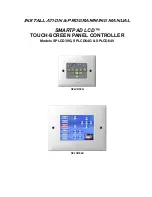
Rev IM/GN-CM-EN/1.0 Copyright© October, 2020 Canadian Solar Inc. 7
5.1 MODULE WIRING
Correct wiring scheme
Cable management scheme should be reviewed and approved by the EPC contractor; in particular required
cable lengths should be cross-checked considering the specificities of the tracker structure like bearing
house gaps. If longer cable or additional jumper cable is requested, please contact Canadian Solar’s sales
representative in advance.
Ensure that the wiring is correct before starting up the system. If the measured open circuit voltage (Voc)
and short-circuit current (Isc) differ from the specifications, this indicates that there is a wiring fault.
When modules have been pre-installed but the system has not been connected to the grid yet, each
module string should be kept under open-circuit conditions and proper actions should be taken to avoid
dust and moisture penetration inside the connectors.
The maximum distance between two adjacent module frames should be within 50 mm (1.96in) for the side
with mounting clamps, and within 25 mm (0.98in) for the side without mounting clamps, in order to meet
the system cable scheme.
Correct connection of plug connectors
Make sure that all connections are safe and properly mated. The PV connector should not be subjected to
stress from the exterior. Connectors should only be used to connect the circuit. They should never be used
to turn the circuit on and off.
Connectors are not waterproof when unmated. When installing modules, connector should be connected
to each other as soon as possible or appropriate measures (like using connector endcaps) should be taken
to avoid moisture and dust penetrating into the connector.
Do not clean or precondition the connectors using lubricants or any unauthorized chemical substances.
Use of suitable materials
Only use dedicated solar cable and suitable connectors (wiring should be sheathed in a sunlight-resistant
conduit or, if exposed, should itself be sunlight-resistant)
that meet local fire, building and electrical
regulations. Please ensure that all wiring is in perfect electrical and mechanical condition.
Installers may only use single-conductor cable listed and labeled as USE-2 or PV wire which is 90°C wet
rated in North America, and single conductor cable, 2.5-16 mm² (5-14 AWG), 90°C wet rated in other areas
(i.e. TUV 2PfG1169 or EN50618 approved), with proper insulation which is able to withstand the maximum
possible system open-circuit voltage.
Only copper conductor material should be used. Select a suitable conductor gauge to minimize voltage
drop and ensure that the conductor ampacity complies with local regulations (
i.e.
NEC 690.8(D))..
Cable and connector protection
Secure the cables to the mounting system using UV-resistant cable ties. Protect exposed cables from
damage by taking appropriate precautions (e.g. placing them inside a metallic raceway like EMT conduit).
Avoid exposure to direct sunlight.
A minimum bending radius of 60 mm (2.36 in) is required when securing the junction box cables to the
racking system.
Do not place connectors in locations where water could easily accumulate.




































